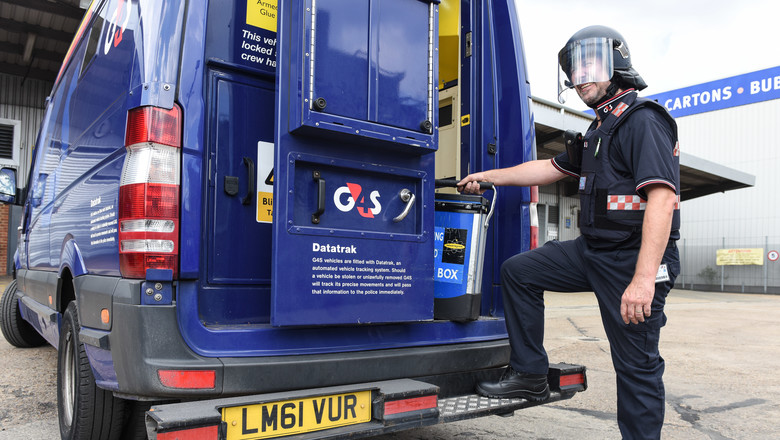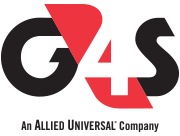
Cash attacks driven down
by Intelligent partnerships

It’s 3pm on a bright spring afternoon when a G4S cash courier arrives at a major supermarket store in Bradford for a routine cash collection.
Within two seconds of leaving the armoured van to enter the store, she is viciously attacked from behind by two men, one carrying a machete.
They’ve been expecting her arrival, tipped off by a former store employee, and the victim is left bruised and shocked on the floor as the men escape in a nearby vehicle with two other accomplices and a cash box containing thousands of pounds.
They soon switch to a different car which they then crash into another vehicle and a garden wall, before abandoning it. When police search the second car they find a lump hammer and taser.
Cash transportation is essential to the economy and the vast majority of businesses could not function without it, but as this attack - just one of many - shows; delivering cash can be a very dangerous business. Attacks have reduced considerably over the last decade; in 2009 there were 1060 offences, compared to an average of 200 offences in recent years, however 2017 saw the first increase in offences since 2009.
This set off alarm bells for Gareth Skinner, Head of Operational Risk for G4S Cash Solutions: “We immediately started to think about what we needed to do to bring it back down.
Since 2009 G4S has been a key part of a concerted and successful effort to reduce cash attacks by forming close working relationships and intelligence sharing with the police, other operators and the intelligence service SaferCash.
We are in a better position to tackle a rise in incidents now than we were in 2009 because those strong relationships are now well established, we know what tactics work and we can do what’s needed more quickly to increase the safety of our crews”.
SaferCash, part of the British Security Industry Association, is a security initiative which aims to reduce the number of attacks on cash-in-transit couriers through the effective sharing of intelligence between the industry and police forces nationwide.
Earlier this year Sarah Staff, a 30-year veteran of the Met Police and Flying Squad, was appointed as Head of SaferCash: “New criminal methods emerge all the time as the criminals try to make it easier to steal money” said Sarah. “Ultimately, my aim is to bring the number of offences back down to sub-2016 levels while ensuring the safety of employees and the public.”
“As well as building up a national picture of offences and working with the police and other partners to get the message out quickly, SaferCash also maintains a database which officers can use to see a record of previous offences and arrests. We also carry out analytical work, providing professional opinion on these criminals and their core business.”
For Gareth, SaferCash is essential in reducing attacks: “SaferCash sits in the middle between police forces and private industry, which includes G4S, and as such sees the whole picture. Individual police forces tend to focus on problems in their own area and not see what is happening elsewhere, but if similar offences are being carried out in different areas – close geographically but in different constabularies – then SaferCash is able to link them together to form a bigger picture to help the police address the problem.”
“Having a full national picture means we can identify high-risk areas and preemptively place crews operating in those areas on high alert.
While out on the road, couriers receive live information about threats on their hand-held devices. It works the other way as well. On the first day of initial training we make sure the procedure for reporting and escalating suspicious activity is ingrained in all couriers.”
The close working relationship and sharing of intelligence has helped to prevent numerous attacks before they could take place and led to a number of successful arrests and prosecutions - ensuring that dangerous criminals are off the streets.
Sarah Staff at SaferCash said: “For us it is about gathering nuggets of evidence that helps us to build a bigger picture which we can then feed to both the industry and police. For example, on two different days two separate cash-in-transit crews may report seeing the same suspicious motorbike while out on the road.
Two weeks later that bike may be involved in a robbery, which is information we can then pass on to the police enabling them to conduct a search and make arrests. That’s a recent real-life example, which resulted in two criminals each receiving seven-year sentences.”
“These aren’t victimless crimes, they have a huge impact on couriers and the local community. It’s been really pleasing to see competing companies working together to resolve the issue – at the end of the day it’s about protecting employees and assets.”
Gareth Skinner echoes Sarah’s view about the importance of companies coming together with SaferCash to tackle the issue: “It’s an absolutely business-critical relationship – if we didn’t have SaferCash, and ourselves and our competitors were working individually to achieve the same ends, we would miss the bigger picture. Without it we would risk a return to the days of a thousand-plus attacks a year.”
Cash transportation is essential to the economy and the vast majority of businesses could not function without it, but as this attack - just one of many - shows; delivering cash can be a very dangerous business. Attacks have reduced considerably over the last decade; in 2009 there were 1060 offences, compared to an average of 200 offences in recent years, however 2017 saw the first increase in offences since 2009.
This set off alarm bells for Gareth Skinner, Head of Operational Risk for G4S Cash Solutions: “We immediately started to think about what we needed to do to bring it back down. Since 2009 G4S has been a key part of a concerted and successful effort to reduce cash attacks by forming close working relationships and intelligence sharing with the police, other operators and the intelligence service SaferCash. We are in a better position to tackle a rise in incidents now than we were in 2009 because those strong relationships are now well established, we know what tactics work and we can do what’s needed more quickly to increase the safety of our crews”.
“As well as building up a national picture of offences and working with the police and other partners to get the message out quickly, SaferCash also maintains a database which officers can use to see a record of previous offences and arrests. We also carry out analytical work, providing professional opinion on these criminals and their core business.”
For Gareth, SaferCash is essential in reducing attacks: “SaferCash sits in the middle between police forces and private industry, which includes G4S, and as such sees the whole picture. Individual police forces tend to focus on problems in their own area and not see what is happening elsewhere, but if similar offences are being carried out in different areas – close geographically but in different constabularies – then SaferCash is able to link them together to form a bigger picture to help the police address the problem.”
“Having a full national picture means we can identify high-risk areas and preemptively place crews operating in those areas on high alert. While out on the road, couriers receive live information about threats on their hand-held devices. It works the other way as well. On the first day of initial training we make sure the procedure for reporting and escalating suspicious activity is ingrained in all couriers.”
The close working relationship and sharing of intelligence has helped to prevent numerous attacks before they could take place and led to a number of successful arrests and prosecutions - ensuring that dangerous criminals are off the streets. Sarah Staff at SaferCash said: “For us it is about gathering nuggets of evidence that helps us to build a bigger picture which we can then feed to both the industry and police. For example, on two different days two separate cash-in-transit crews may report seeing the same suspicious motorbike while out on the road. Two weeks later that bike may be involved in a robbery, which is information we can then pass on to the police enabling them to conduct a search and make arrests. That’s a recent real-life example, which resulted in two criminals each receiving seven-year sentences.”
“These aren’t victimless crimes, they have a huge impact on couriers and the local community. It’s been really pleasing to see competing companies working together to resolve the issue – at the end of the day it’s about protecting employees and assets.”
Gareth Skinner echoes Sarah’s view about the importance of companies coming together with SaferCash to tackle the issue: “It’s an absolutely business-critical relationship – if we didn’t have SaferCash, and ourselves and our competitors were working individually to achieve the same ends, we would miss the bigger picture. Without it we would risk a return to the days of a thousand-plus attacks a year.”
